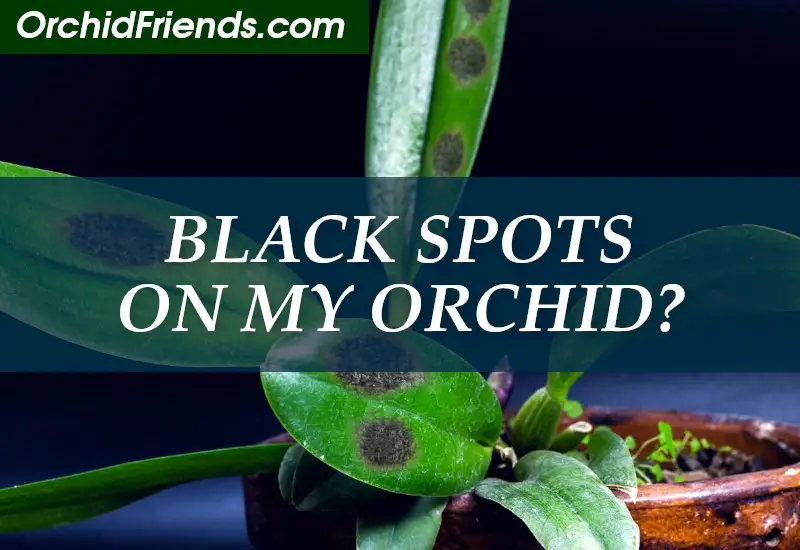
** This post is written and edited by a human being **
What Are the Black Spots on My Phalaenopsis Orchids?
If you’ve noticed black spots appearing on the leaves of your Phalaenopsis orchid, you’re not alone. This is a common issue among orchid growers, and while it can be concerning, understanding the cause of the spots and how to treat them is key to keeping your plant healthy. Black spots on Phalaenopsis orchids can be caused by a variety of factors, including disease, environmental stress, and improper care. In this article, we’ll explore the different reasons why these spots appear and how you can address the issue.
1. Fungal or Bacterial Infections
One of the most common causes of black spots on Phalaenopsis orchids is fungal or bacterial infections. These infections usually develop when the orchid is exposed to excessive moisture, poor air circulation, or high humidity levels. Orchids are susceptible to fungal and bacterial diseases, especially if water has accumulated on the leaves and not dried properly.
Signs of fungal or bacterial infections:
- Black or dark brown spots on the leaves, often with a water-soaked appearance.
- The spots may spread or grow larger over time.
- If the infection is bacterial, you may notice a foul odor emanating from the affected areas.
- Fungal infections often appear as small, dark lesions with defined edges.
What to do:
- Remove affected leaves: If the black spots are localized and on older or lower leaves, it’s best to remove these leaves to prevent the infection from spreading. Use sterilized scissors or pruning shears to avoid further contamination.
- Improve air circulation: Ensure your orchid is in a well-ventilated area with good airflow. This helps reduce the humidity around the leaves and keeps moisture from lingering on the surface.
- Watering practices: Be cautious when watering your Phalaenopsis orchid. Avoid getting water on the leaves, especially when the plant is in a cooler environment. Water in the morning so the plant has time to dry during the day.
- Use fungicides or bactericides: If the infection is severe, consider applying a fungicide or bactericide specifically designed for orchids. Follow the product’s instructions carefully.
2. Overwatering
Overwatering is one of the most common care mistakes when growing Phalaenopsis orchids. Orchids are sensitive to excess moisture, and when the roots are constantly wet, they cannot properly absorb oxygen. This leads to root rot, which can, in turn, cause black spots on the leaves as the plant struggles to take in nutrients.
Signs of overwatering:
- Black spots on the leaves, especially near the base of the plant.
- Yellowing leaves and wilting.
- Mushy or blackened roots.
What to do:
- Check the roots: If you suspect overwatering, carefully remove the orchid from its pot and inspect the roots. Healthy roots should be firm and white or light green, while rotting roots will be dark brown or black and mushy. Trim away any damaged roots with sterilized scissors.
- Repot your orchid: If you’ve removed rotting roots, repot your Phalaenopsis in fresh, well-draining orchid mix. Make sure the new pot has drainage holes to allow excess water to escape.
- Adjust your watering routine: Allow the orchid’s potting mix to dry out slightly between waterings. Water thoroughly, but make sure the orchid is never left sitting in standing water.
3. Sunburn or Environmental Stress
Excessive sunlight or sudden changes in temperature can stress your Phalaenopsis orchid, causing black spots on the leaves. Orchids are naturally shaded plants, and when exposed to too much direct sunlight, their leaves can get scorched, leading to black or brown spots. Similarly, sudden drafts or changes in temperature can weaken the plant, making it more prone to damage.
Signs of sunburn or environmental stress:
- Black or brown spots that appear suddenly and are often accompanied by yellowing.
- The affected areas may have a dry or leathery texture.
- The spots are usually found on the side of the leaves that are exposed to the light.
What to do:
- Move the orchid: If your Phalaenopsis orchid is getting too much direct sunlight, move it to a location with bright, indirect light. Orchids thrive in filtered light, so placing them near a window with sheer curtains or in a spot where they receive only indirect sunlight is ideal.
- Monitor temperature and humidity: Make sure your orchid is kept in a stable environment. Avoid placing it near drafts, air conditioners, or heaters, as these temperature fluctuations can stress the plant.
- Increase humidity: Orchids love humidity, so consider using a humidity tray or a room humidifier to create a more favorable environment for your plant.
4. Poor Air Circulation or Humidity Issues
Phalaenopsis orchids need good air circulation and consistent humidity to thrive. If the air is too dry or stagnant, this can cause stress on the plant, leading to black spots. Poor air circulation also allows for fungal and bacterial infections to take hold more easily.
Signs of poor air circulation or humidity:
- Black spots, particularly in areas of the leaves that don’t receive good airflow.
- Dry or shriveled leaves.
What to do:
- Improve air circulation: Ensure that your orchid is in a location with good airflow. A fan set on low can help circulate the air around the plant.
- Maintain humidity: Phalaenopsis orchids prefer humidity levels of around 50-70%. If the air in your home is too dry, use a humidity tray or a humidifier to maintain proper moisture levels around the plant.
Conclusion
Black spots on your Phalaenopsis orchid can be caused by a variety of factors, from fungal or bacterial infections to improper care like overwatering or sunburn. The key to resolving the issue is identifying the underlying cause and adjusting your care routine accordingly. By improving watering practices, ensuring proper air circulation, and providing the right light and humidity conditions, you can help your Phalaenopsis orchid recover and continue to thrive. Always remember to monitor your plant regularly to catch potential problems early and keep it healthy and beautiful.
Why is My Orchid Crown Turning Brown
If you’ve noticed the crown of your Phalaenopsis orchid turning brown, it can be concerning, but understanding the cause is the first step in addressing the issue. The crown is the central growing point where new leaves emerge, so any damage here can affect the overall health of the plant. Several factors can cause the crown to turn brown, and it’s important to pinpoint the cause to prevent further damage.
1. Overwatering and Root Rot
Overwatering is one of the leading causes of crown rot. When an orchid is watered too frequently or the potting mix doesn’t drain well, the roots can become waterlogged. This deprives the roots of oxygen, causing them to rot. If the roots rot, the crown often becomes the next area to suffer, as the plant is no longer able to transport water and nutrients effectively. Brown, mushy spots may appear at the top of the plant, starting at the crown.
Solution: If you suspect overwatering, check the roots for signs of rot—healthy roots should be firm and white or light green. Trim any rotting roots, repot your orchid in fresh, well-draining medium, and adjust your watering routine to avoid future overwatering.
2. Fungal or Bacterial Infections
Fungal or bacterial infections can also cause brown spots at the crown. These infections thrive in warm, humid environments and can spread rapidly if not addressed. If your orchid’s crown looks discolored, soft, or wet, it may be a sign of infection.
Solution: Remove any infected parts of the plant using sterile scissors. You can treat fungal infections with a fungicide designed for orchids and improve airflow around the plant to reduce humidity buildup.
3. Sunburn or Temperature Stress
Phalaenopsis orchids prefer bright, indirect light. If the plant is exposed to direct sunlight or temperature extremes, the crown can burn, turning brown or even black.
Solution: Move the orchid to a spot with indirect, filtered light and ensure the plant isn’t subjected to temperature fluctuations.
By diagnosing the cause of the browning crown and taking appropriate action, your orchid can recover and continue to thrive. Good luck!



